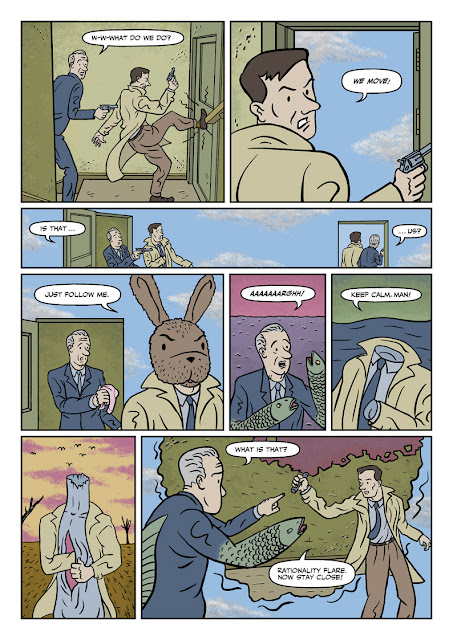“There
is no truth. There is only perception.” – Gustave Flaubert
I
have a complicated relationship with my understanding of reality.
What I often mistake as hard truths become, with a slight change in
perspective, something entirely new.
Take
the tuna fish sandwich for example.
For
over forty years, the tuna fish sandwich had been a simple comfort
food for me, something nice and reassuring in the middle of the
afternoon, filled with memories of childhood and innocence –
straightforward, uncomplicated, yummy. Tuna, mayo, bread, GO!
Then,
one day, a friend of mine gave me a tuna fish sandwich that had the
addition of grated onion, diced celery, eggs, chopped sweet pickles,
a squeeze of fresh lemon juice, salt, pepper, and mayonnaise mixed
with a little half and half and my ordinary comfort sandwich became
one of the most delicious things I had ever put in my mouth. My
perception of the tuna fish sandwich bent, reassembled, and became
something else. In that moment, through an act of artistic intent
(for that is what good cooking is), what once was would never be
again.
The
hard and fast truth of the tuna fish sandwich I had held on to for so
long was destroyed in that moment and, damn, if I am not the better
person for it.
Anais
Nin once wrote, “It
is the function of art to renew our perception. What we are familiar
with we cease to see.”
For me, the tuna fish sandwich had become that nail hole in the wall
that, after years of being there above your bed, you no longer notice
due to its ever-present existence. By making it new, my friend
brought this sandwich back to me in a unique way and forever changed
my relationship with it.
Perception
is the purview of the artist. In his or her creative hands lies the
power to unleash new realities for his or her audience. By altering
our relationship with that which we have ceased to see, the artist,
god-like in a way, allows us to understand our place in the world in
a more universal fashion.
Which
brings me, at last, to begin my love letter to New Zealand cartoonist
Jonathan King's latest collection, Perplexing
Stories: Middling Tales to Bemuse.
I've
been a fan of King's comics since I first read “Bookish”, his
contribution to the first issue of the New Zealand comics anthology
Faction. Issue three of Faction contained King's “The Night Limited” which cemented my sense that
not only is King a phenomenal storyteller and cartoonist, but he is
also an artist in the truest sense insofar as he uses his creative
powers to move his audience from the staid and comfortable into wild
places fraught with unexpected pushes to the softer parts of our
brains.
His
stories are narratives insomuch as they have a beginning, middle,
and end. His panels familiar, as they are clean, representational,
Hergé-influenced,
and artful. You can wrap your head around King's stories as you would
any other popular comic, but within that process, things bend,
unhinge, evolve.
And
you are left with something else. Something new. Something beautiful.
On
the back of Perplexing
Stories,
King calls this a “collection of seven surreal sequential ligne
claire comic curiosities, curated for your bemusement,” which is as
apt a description as there ever was. King works in the unexpected,
the transformative, the surreal. He takes to heart Dali's dictum that
“Surrealism
is destructive, but it destroys only what it considers to be shackles
limiting our vision.”
Like Dali's work, King goads us to make new connections, challenges
us to find the humor in the absurd, and pushes us beyond our calm
self-restraint.
Perplexing
Stories
contains the previously mentioned ”Bookish” and “The Night
Limited” which are wonderful to revisit. It also contains one of
his early comics, “Transmission”, a crop-circle story that is
bold in its unexpected structural completion; “Way to Go”, a
poignant short comic King did in support of victims of the 2011
earthquake in Christchurch; and “Oh No, It's The Tripods!”, a
one pager that just drops your jaw in the last panel.
Of
particular note, though, are the two stories that bookend this
collection. The first story is called “Defense” – which takes
the idea of a Thesis Oral Examination to places that only a true
surrealist would think to go and, therein, makes it a glorious
commentary on the process, the affectation, and the nature of this
beast.
The
final piece in Perplexing
Stories
is one of my favorite, though. “Threat Level” revels in and
reveres the very idea of Surrealism, setting it up initially as
something to be feared, an act of terrorism on reality, but, through
King's understanding, is revealed to be something profoundly
celebratory, necessary, and wonderful. I know that I will be
returning to this collection again and again when I feel myself
starting to bog down in the day to day; I know that reading “Threat
Level” will always help me grab hold of the nuance that exists
outside of my peripheral vision, the sight I need to continuously
look at the world anew, and allow me to once again extol all the
moments a person no longer sees because he or she has been staring at
them for far too long.
It
takes an artist to help us perceive that which is in front of us. It
takes an artist to remind us that life is extraordinary and
spectacular in all of its moments. The work of Jonathan King is the
work of an artist.
Let
me tell you, he
makes one hell of a tuna fish sandwich.
To
find out more about Perplexing
Stories: Middling Tales to Bemuse,
go to Jonathan King's website, Eel Noir, at http://www.jking.co.nz/





No comments:
Post a Comment